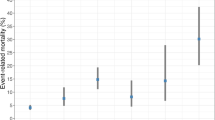Abstract
There is no report analysing pediatric severity scoring systems in British Intensive Therapy Units (ICUs). Two previously reported pediatric severity scoring systems, the Admission Physiologic Stability Index (APSI) and the Organ System Failure (OSF) score were evaluated for 151 patients. The APSI was higher for children who died than for those who lived (p<0.001). This difference reflected the sharp distinction between the APSI for chilren who left intensive care within 24 h and those remaining in ICU longer than 24h (p<0.001). For children remaining in ICU longer than 24 h, there was a large overlap of APSI scores, and the APSI did not discriminate between children in the overlap region who lived and those who died (p=0.054). There was underscoring of neurological patients; the APSI did not differentiate neurological patients whole lived and those who died (p>0.10). The OSF also underscored neurological patients. Increasing number of organ systems failed was associated with increasing mortality. In contrast to previous reports, however, the mortality rate was unaffected by whether the total number of systems failed simultaneously or non-simultaneously. There is still a need for a comprehensive yet simple pediatric scoring system for comparing the efficacy and outcome of pediatric intensive care in different ICUs in different countries.
Similar content being viewed by others
References
Beaufils F, Roze JC, Hamoir GF, Bloc D, Floret D, Stopfkuchen H, De Jong de Vos Van Steenwijk CCE, Van der Voort E, Mar Molinero F (1987) Evaluation of pediatric intensive care in Europe. Intensive Care Med 13:65
Knauss WA, Draper EA, Wagner DP, Zimmerman JE (1985) APACHE II: a severity of disease classification system. Crit Care Med 13:818
Yeh TS, Pollack MM, Ruttimann UE, Holbrook PR, Fields AI (1984) Validation of a physiologic stability index for use in critically ill infants and children. Ped Res 18:445
Wilkinson JD, Pollack MM, Ruttimann UE, Glass NL, Yeh TS (1986) Outcome of pediatric patients with multiple organ system failure. Crit Care Med 14:271
Pollack MM, Ruttimann UE, Getson PR and Members of the Multi-Institutional Study Group (1987) Accurate prediction of the outcome of pediatric intensive care: a new quantitative method. N Engl J Med 316:134
Wilkinson JD, Pollack MM, Glass NL, Kanter RK, Katz RW, Steinhart CM (1987) Mortality associated with multiple organ system failure and sepsis in pediatric intensive care unit. J Pediatr 111:324
Chang RWS, Jacobs S, Lee B (1986) Use of APACHE II severity of disease classification to identify Intensive-Care-Unit patients who would not benefit from total parenteral nutrition. Lancet I:1483
Tasker RC, Boyd S, Harden A, Matthew DJ (1988) Monitoring in non-traumatic coma. Part II: electroencephalography. Arch Dis Child 63:895
Author information
Authors and Affiliations
Rights and permissions
About this article
Cite this article
Price, H.L., Matthew, D.J. Evaluation of pediatric intensive care scoring systems. Intensive Care Med 15, 79–83 (1989). https://doi.org/10.1007/BF00295981
Received:
Accepted:
Issue Date:
DOI: https://doi.org/10.1007/BF00295981




